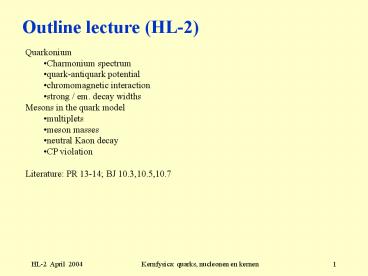Outline lecture (HL-2) PowerPoint PPT Presentation
1 / 34
Title: Outline lecture (HL-2)
1
Outline lecture (HL-2)
- Quarkonium
- Charmonium spectrum
- quark-antiquark potential
- chromomagnetic interaction
- strong / em. decay widths
- Mesons in the quark model
- multiplets
- meson masses
- neutral Kaon decay
- CP violation
- Literature PR 13-14 BJ 10.3,10.5,10.7
2
hadron resonances
J/? production
?h
Intermediate hadron state (decaying into leptons,
hadrons) interpreted as bound state (JP1-)
??
J/? resonance ?e?? 4.8 keV, ?h 59 keV
(lepton universality)
? 69 keV
?e
c
c
bound states ? transitions between excited
states
3
Crystal Ball (structure like Plastic Ball)
hollow sphere from ca. 900 NaI crystals around
interaction point
4
charmonium ? decay spectrum
Level scheme reminds of positronium states n 2S1
Lj states characterized by parity P
(-1)L1 charge conjugation parity C
(-1)LS strong electric dipole ?L1,
?S0 transitions
5
charmonium level scheme
only JPC 1 directly accessible
in e e- production ?C states reached
by magnetic dipole ?L0, ?S1 spin-flip
transitions (weaker than electric transitions)
narrow states below threshold hindered
by energy limit and OZI suppressed
6
quark-antiquark potential
level sequence reminds of positronium
system Coulomb-like potential (g exchange force,
short range color
charge 4/3 ) with linear confinement (asymptotic
freedom)
hints for ln(r) dependence from bottonium levels
7
realistic qq potential from Lattice QCD
solving Schr. eq. with QCD Lagrangian on a
discrete space-time lattice
hybrid potential from glue excitations
states predicted
discovery possible at future GSI accelerator
ground state potential
r00.5 fm
8
access to charmonium states in
annihilation
many unknown states and transitions
hyperfine S-state splitting 120 MeV
9
chromomagnetic interaction
strong (hyperfine) splitting of S states, like in
positronium zero-range spin-spin
interaction, point interaction of magnetic
moments of e e-
modified for color-magnetic qq force (eff.
interaction, constituent mass)
color-magnetic energy splitting
10
charmonium and bottonium levels
smaller hyperfine splitting in system due
to larger b-quark mass
11
bottonium level scheme
similar level structure (mc ?1.3 GeV, mb ?4.3
GeV)
flavour independent qq potential, surprising mas
s difference of lowest states
?
(9460) resonance upsilon ?53
keV
sensitive to long-range part of qq potential ? r,
? ln(r)
12
quarkonium em / strong decay width
positronium decay width
2? decay width
(including higher order radiative corrections
?rad. )
2g decay width
ratio of decay widths
consistent with ?S from level spectrum
13
Outline lecture (HL-2)
- Quarkonium
- Charmonium spectrum
- quark-antiquark potential
- chromomagnetic interaction
- strong / em. decay widths
- Mesons in the quark model
- multiplets
- masses
- neutral Kaon decay
- CP violation
14
mesons in the quark model
similar light quark masses treated on same
footing
in isospin (I3) and hypercharge (Y)
YBS
15
products of SU(3) representations
YBS
1
1/3
1/2
I3
16
meson multiplets (lowest L0 states)
pseudoscalar (JP 0- ) octet singlet
vector (JP 1- ) octet singlet
17
mixing of multiplet states
- SU(3) symmetry broken by s-quark mass larger than
u, d mass - mixing of I0 multiplet states ? of same JP
- physical states ?
from experimental meson masses for pseudoscalar
(0-), vector (1-) and tensor (2) mesons ideal
mixing (35o) ?octet state pure ?explanation of
branching fractions
s
s
18
color-magnetic energy splitting
remember charmonium S-state splitting 120 MeV
J 1 mass gap 600 MeV/c2 J 0
19
meson masses
calculated from constituent quark masses and
color-magnetic mass splitting
free parameters constituent q masses
20
decay channels of lightest mesons
strong decay not possible for lightest meson
strong decay I-spin forbidden
strong decay
mixing
21
CP eigenstates
Parity violating decay fast slow
(phase-space restricted)
p
p
0
3
and
2
K
S- but not CP eigenstates
construct CP eigenstates (physical states) as
linear combination of S-eigenstates
22
K0 mixing and regeneration
450 GeV p
23
Summary lecture (HL-2)
- Quarkonium
- Charmonium spectrum (partly explored)
- ? quark-antiquark potential (Coulomb like)
- level splitting chromomagnetic interaction
- ? long range part (asymptotic freedom)
- strong / em. decay widths
- ? coupling strength
- Mesons in the quark model
- multiplets
- masses ? broken SU(3) symmetry mixing
- neutral Kaon decay CP eigenstates
- CP violation
24
AdditionBaryons in the quark model
- production
- multiplets
- masses
- Literature PR 15 BJ 9, 10.4 -10.6
25
pion nucleonscattering
Isospin coupling, invariant mass (4-mom. sum) and
phase-shift analysis yield energy (mass), I, L,
J resonance assignment L2I,2J (mass) and width
(lifetime)
26
phase-shift analysis
quantum scattering in 3 dimensions (halfplane ?0)
27
phase-shift analysis (2)
will contain interferences of partial waves l ?
particular angular distributions
total cross section
28
phase-shift analysis (3)
elastic scattering
max. cross section for resonance condition!
at resonance energy E ER
purely imaginary!!
29
phase-shift analysis (4)
expand partial wave amplitude Tl around resonance
energy
30
phase-shift analysis (5)
generalization
Breit-Wigner resonance (non-relativistic)
31
quark-flow diagrams
quark composition in intermediate (10-23 s) state
32
baryon multiplets
color-neutral lowest energy (L0) qqq states
require symmetric
small (.1) e.m. splitting of Isospin
multiplets strong SU(3) breaking
33
baryon mass spectrum
I(?)0I(s)I(ud) ??(ud) antisymmetric ??(ud)
antisymmetric ?spin(ud)0 ?spin(?)spin(s)1/2
- - ? mass splitting
- 80 MeV/c2
- due to
- spin-spin interaction
uds
usd
34
Summary addition
- Baryons in the quark model
- multiplets and SU(3) breaking
- masses spin-spin interaction

